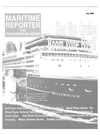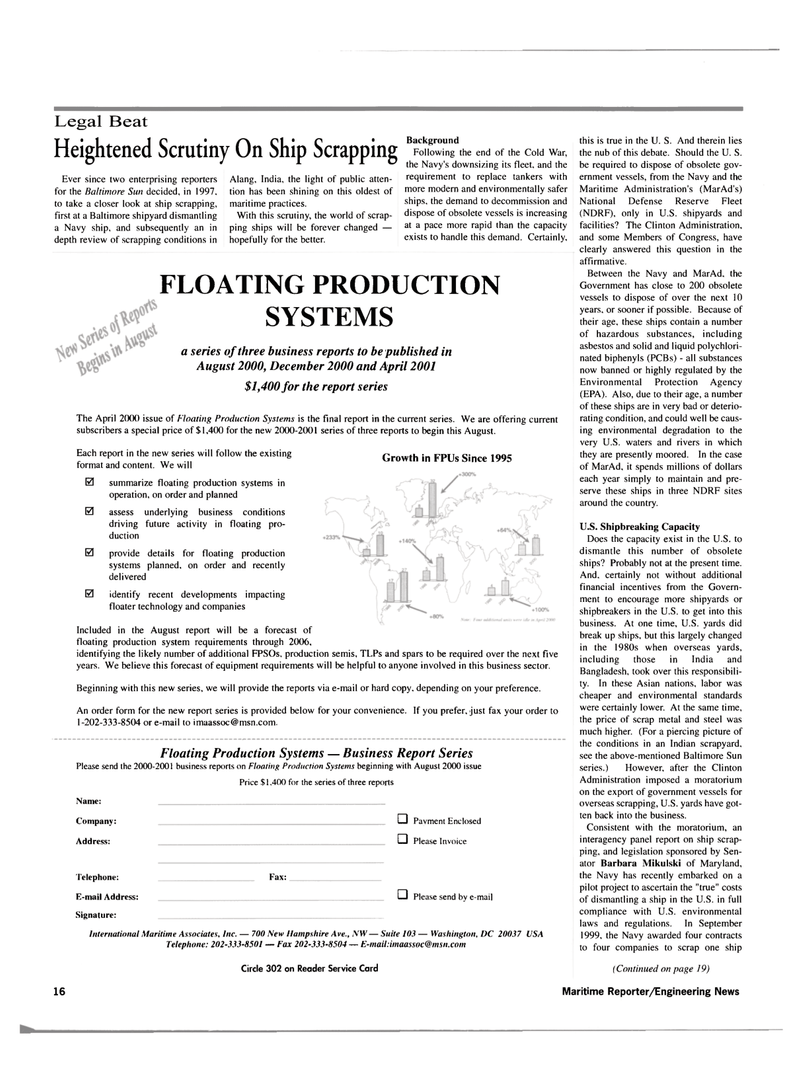
Page 16: of Maritime Reporter Magazine (July 2000)
Read this page in Pdf, Flash or Html5 edition of July 2000 Maritime Reporter Magazine
Legal Beat
Heightened Scrutiny On Ship Scrapping
Ever since two enterprising reporters for the Baltimore Sun decided, in 1997. to take a closer look at ship scrapping, first at a Baltimore shipyard dismantling a Navy ship, and subsequently an in depth review of scrapping conditions in
Alang, India, the light of public atten- tion has been shining on this oldest of maritime practices.
With this scrutiny, the world of scrap- ping ships will be forever changed — hopefully for the better.
Background
Following the end of the Cold War, the Navy's downsizing its fleet, and the requirement to replace tankers with more modern and environmentally safer ships, the demand to decommission and dispose of obsolete vessels is increasing at a pace more rapid than the capacity exists to handle this demand. Certainly, this is true in the U. S. And therein lies the nub of this debate. Should the U. S. be required to dispose of obsolete gov- ernment vessels, from the Navy and the
Maritime Administration's (MarAd's)
National Defense Reserve Fleet (NDRF), only in U.S. shipyards and facilities? The Clinton Administration, and some Members of Congress, have clearly answered this question in the affirmative.
Between the Navy and MarAd, the
Government has close to 200 obsolete vessels to dispose of over the next 10 years, or sooner if possible. Because of their age, these ships contain a number of hazardous substances, including asbestos and solid and liquid polychlori- nated biphenyls (PCBs) - all substances now banned or highly regulated by the
Environmental Protection Agency (EPA). Also, due to their age, a number of these ships are in very bad or deterio- rating condition, and could well be caus- ing environmental degradation to the very U.S. waters and rivers in which they are presently moored. In the case of MarAd, it spends millions of dollars each year simply to maintain and pre- serve these ships in three NDRF sites around the country.
U.S. Shipbreaking Capacity
Does the capacity exist in the U.S. to dismantle this number of obsolete ships? Probably not at the present time.
And. certainly not without additional financial incentives from the Govern- ment to encourage more shipyards or shipbreakers in the U.S. to get into this business. At one time, U.S. yards did break up ships, but this largely changed in the 1980s when overseas yards, including those in India and
Bangladesh, took over this responsibili- ty. In these Asian nations, labor was cheaper and environmental standards were certainly lower. At the same time, the price of scrap metal and steel was much higher. (For a piercing picture of the conditions in an Indian scrapyard, see the above-mentioned Baltimore Sun series.) However, after the Clinton
Administration imposed a moratorium on the export of government vessels for overseas scrapping, U.S. yards have got- ten back into the business.
Consistent with the moratorium, an interagency panel report on ship scrap- ping, and legislation sponsored by Sen- ator Barbara Mikulski of Maryland, the Navy has recently embarked on a pilot project to ascertain the "true" costs of dismantling a ship in the U.S. in full compliance with U.S. environmental laws and regulations. In September 1999, the Navy awarded four contracts to four companies to scrap one ship (Continued on page 19)
FLOATING PRODUCTION
SYSTEMS a series of three business reports to be published in
August 2000, December 2000 and April 2001 $1,400for the report series
The April 2(XX) issue of Floating [Production Systems is the final report in the current series. We are offering current subscribers a special price of $1,400 for the new 2000-2001 series of three reports to begin this August.
Growth in FPUs Since 1995 Each report in the new series will follow the existing format and content. We will 0 summarize floating production systems in operation, on order and planned 0 assess underlying business conditions driving future activity in floating pro- duction 0 provide details for floating production systems planned, on order and recently delivered 0 identify recent developments impacting floater technology and companies
Included in the August report will be a forecast of floating production system requirements through 2006, identifying the likely number of additional FPSOs, production semis, TLPs and spars to be required over the next five years. We believe this forecast of equipment requirements will be helpful to anyone involved in this business sector.
Beginning with this new series, we will provide the reports via e-mail or hard copy, depending on your preference.
An order form for the new report series is provided below for your convenience. If you prefer, just fax your order to 1-202-333-8504 or e-mail to [email protected].
Floating Production Systems — Business Report Series
Please send the 2000-2001 business reports on Floating Production Systems beginning with August 2000 issue
Price $ 1.400 for the series of three reports
Name:
Company:
Address: • Pavment Enclosed • Please Invoice
Telephone:
E-mail Address:
Signature:
Fax: • Please send by e-mail
International Maritime Associates, Inc. — 700 New Hampshire Ave., YVV— Suite 103 — Washington, DC 20037 USA
Telephone: 202-333-8501 — Fax 202-333-8504 — E-mail:[email protected]
Circle 302 on Reader Service Card 16 Maritime Reporter/Engineering News

 15
15

 17
17
